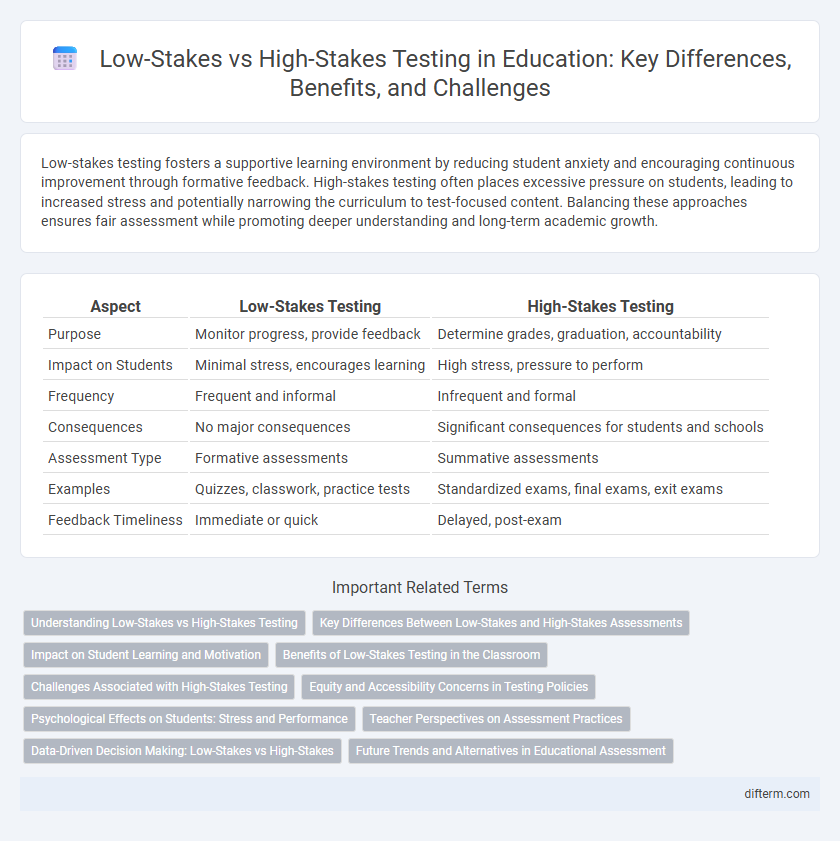Low-stakes testing fosters a supportive learning environment by reducing student anxiety and encouraging continuous improvement through formative feedback. High-stakes testing often places excessive pressure on students, leading to increased stress and potentially narrowing the curriculum to test-focused content. Balancing these approaches ensures fair assessment while promoting deeper understanding and long-term academic growth.
Table of Comparison
| Aspect | Low-Stakes Testing | High-Stakes Testing |
|---|---|---|
| Purpose | Monitor progress, provide feedback | Determine grades, graduation, accountability |
| Impact on Students | Minimal stress, encourages learning | High stress, pressure to perform |
| Frequency | Frequent and informal | Infrequent and formal |
| Consequences | No major consequences | Significant consequences for students and schools |
| Assessment Type | Formative assessments | Summative assessments |
| Examples | Quizzes, classwork, practice tests | Standardized exams, final exams, exit exams |
| Feedback Timeliness | Immediate or quick | Delayed, post-exam |
Understanding Low-Stakes vs High-Stakes Testing
Low-stakes testing, characterized by minimal consequences for outcomes, encourages formative assessment and supports student learning through ongoing feedback, reducing anxiety and promoting skill development. High-stakes testing, in contrast, involves significant consequences such as grade promotion or graduation, often impacting teaching practices and student motivation due to pressure associated with performance. Understanding the distinctions between these testing approaches is critical for educators aiming to balance assessment strategies and optimize educational outcomes.
Key Differences Between Low-Stakes and High-Stakes Assessments
Low-stakes testing typically involves assessments with minimal impact on student grades or progression, promoting formative feedback and reducing anxiety. High-stakes testing, in contrast, carries significant consequences like grade promotion, graduation eligibility, or school funding decisions, often increasing pressure on students and educators. Key differences include the purpose, frequency, and consequences, where low-stakes assessments support ongoing learning and high-stakes tests evaluate critical outcomes.
Impact on Student Learning and Motivation
Low-stakes testing reduces anxiety and encourages deeper learning by allowing students to focus on mastery rather than performance, fostering intrinsic motivation and positive attitudes toward education. High-stakes testing often increases stress, leading to surface-level learning aimed at test performance rather than comprehensive understanding, which can diminish long-term motivation. Research indicates that low-stakes assessments promote sustained student engagement and improve overall academic outcomes by supporting cognitive growth and self-efficacy.
Benefits of Low-Stakes Testing in the Classroom
Low-stakes testing enhances student learning by reducing anxiety and promoting frequent self-assessment, which improves knowledge retention and understanding. These tests create a supportive classroom environment that encourages risk-taking and deeper cognitive engagement without the pressure of significant consequences. Educators benefit from ongoing formative data to tailor instruction and identify areas needing reinforcement, leading to improved academic outcomes.
Challenges Associated with High-Stakes Testing
High-stakes testing often generates significant stress among students, impacting their mental health and performance, while narrowing the curriculum as teachers focus primarily on test preparation. These assessments can exacerbate educational inequalities by disproportionately affecting students from under-resourced schools, limiting opportunities for those already at a disadvantage. Furthermore, high-stakes testing may encourage teaching to the test, reducing instructional innovation and critical thinking development.
Equity and Accessibility Concerns in Testing Policies
Low-stakes testing promotes equity by reducing pressure on students, allowing diverse learners to demonstrate knowledge without disproportionate consequences. High-stakes testing often exacerbates disparities due to unequal access to resources and supports, disproportionately affecting marginalized groups. Equitable testing policies prioritize accessibility, ensuring all students receive accommodations and culturally responsive assessments to accurately measure learning outcomes.
Psychological Effects on Students: Stress and Performance
Low-stakes testing reduces student anxiety by prioritizing learning over outcomes, fostering a positive environment conducive to cognitive growth. High-stakes testing often triggers significant stress, impairing memory recall and performance due to pressure and fear of failure. Research shows that balanced assessment approaches improve student well-being while maintaining academic rigor.
Teacher Perspectives on Assessment Practices
Teacher perspectives on assessment practices highlight distinct differences between low-stakes and high-stakes testing, with many educators favoring low-stakes tests for their ability to provide ongoing feedback without the pressure of significant consequences. Low-stakes assessments promote formative learning, enabling teachers to adjust instruction and support student growth effectively. Conversely, high-stakes testing often leads to teaching to the test and increased anxiety, which can undermine authentic learning experiences and limit instructional creativity.
Data-Driven Decision Making: Low-Stakes vs High-Stakes
Low-stakes testing generates frequent, formative data that allows educators to make timely, data-driven decisions to tailor instruction and support individual student needs. High-stakes testing produces summative data primarily used for accountability, often limiting immediate instructional adjustments due to its infrequent administration and high-pressure environment. Data-driven decision making benefits from integrating low-stakes assessments to promote continuous feedback cycles, while high-stakes results help inform broader policy and resource allocation.
Future Trends and Alternatives in Educational Assessment
Emerging trends in educational assessment emphasize low-stakes testing to reduce student anxiety and provide continuous feedback for personalized learning pathways. Digital platforms and adaptive testing technologies enable real-time data analytics, supporting formative assessments that guide instructional strategies. Alternative models like project-based assessments and competency-based evaluations are gaining traction as they more accurately measure student skills and knowledge application in diverse learning environments.
low-stakes testing vs high-stakes testing Infographic

 difterm.com
difterm.com